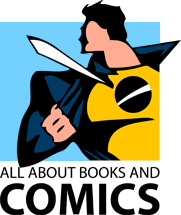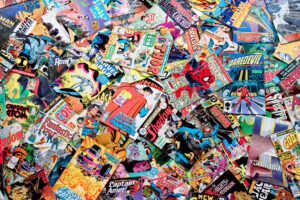Captain America: Theater of War: America the Beautiful #1 — Writer: Paul Jenkins; Art: Gary Erskine; (Second story): Writer: Dan Jurgens; Art: Jerry Ordway
Two stories with similar arcs: start in the present, then flash back to WWTT. The first is better written, one of those scared-rookie-finds-his-courage deals, set during the D-Day invasion; it’s cliched, but hits all the right beats. I’m not a big fan of Erskine’s art, but it brings a gritty realism that’s appropriate to the story. The second tale, which flashes back to the Battle of the Bulge, looks more comic-booky (almost like an inventory story), and brings in Nick Fury, both with Cap in the present, and back during the war.
Mysterius The Unfathomable #1 — Writer: Jeff Parker; Art: Tom Fowler
Fowler has a knack with grotesques, reminiscent of Mike Ploog, and brings a certain sleazy uniqueness to this tale of a supernatural detective. The use of a new assistant as the narrative focus/reader stand-in is effective, although the story itself is just OK — kind of Hellblazer lite, with WC Fields filling in for John Constantine (it’s the kind of thing that reads like a failed TV pilot for one of those late-night detective-show slots).
The Three Geeks: Slab Madness #1(of 3) — Writer/Artist: Rich Koslowski
Koslowski’s fanboy crew returns for a mini-series, with the “slabs” referring to CGC books. I was expecting a rant against the things, but it goes in a much different direction (with a full page ad from CGC on the back cover, too). It’s cute enough; Koslowski’s never going to be Neal Adams, but he’s developed a knack for staging and panel composition, in his own cartoony way, and his knowing in-jokes and gentle jibes at fan obsessions are worth a look.
Spider-Man: Noir #2 (of 4) — Writers: David Hine with Fabrice Sapolsky; Art: Carmine di Giandomenico
Ah… so these Noir books can involve super-powers: the first issues of both this and the X-Men title made it seem like we were in the “real” world of the 1930s, but this second installment makes it clear that we’re doing pulp heroes instead. Good, because that makes it considerably more interesting, although at base it’s still a Marvel Elseworlds tale, with the standard cast all present in their standard variations. I tend to see these things as more intellectual exercises than must-have, compelling narratives, but if you’re interested in them, here one is.
Justice League of America #29 — Writer: Len Wein; Penciller: Chris Cross; Inkers: Rob Stull with Chris Cross
As with the Libra one-shot from a few weeks ago, this is a retelling of two earlier JLA books, both involving the villain Starbreaker (presumably because he’s about to appear in the current JLA continuity, and because it gives that creative team a one-issue break). OK, and it’s nice to see Wein getting work, although nothing really gets added to the original versions, and I kept wanting to see Dick Dillin’s art; Cross’s seems too modern for the late-Silver-Age tone here.
Punisher #66 — Writer: Duane Swierczynski; Artist: Michel Lacombe
Swiercynski takes a shot a writing Frank Castle’s adventures, beginning with an “I’ve been poisoned and have six hours to live” riff. Yeah, whatever; I find the Punisher such a standard concept that I can only get into it with a really good writer (Garth Ennis, of course, and back in the day I thought Mike Baron had a good take on him), and so these competent-but-standard stories leave me cold.
Black Lightning: Year One #2 (of 6) — Writer: Jen Van Meter; Art: Cully Hamner
Better than the first issue, in that there’s more actual costumed action, but this still seems too… I don’t know, “earnest”? for it’s own good; it’s a superhero book that should be loud, flashy, funny and suspenseful, and it only hits maybe one and a half out of those four notes. In a highly competitive marketplace, it’s well-intentioned and careful work that’s going to disappear without a trace.
Phil Mateer


